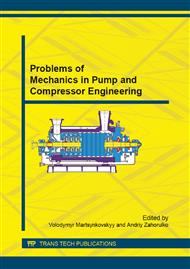[1]
A. El-Shafei, Developments in Fluid Film Bearing Technology, IUTAM Symposium on Emerging Trends in Rotor Dynamics, 1011 (2011) 201-215.
DOI: 10.1007/978-94-007-0020-8_18
Google Scholar
[2]
B.S. Herbage, High efficiency fluid film thrust bearings for turbomachinery, 6th Proceedings of the Turbomachinery Symposium, Texas A&M University, (1977) 33-38.
Google Scholar
[3]
T. Nakano, Y. Waki, K. Yamashita, T. Kaikogi, M. Uesato, Y. Yamada, Development of Thrust and Journal Bearings with High Specific Load for Next Generation Steam Turbine, Proceedings of the International Conference on Power Engineering, 5 (2007).
DOI: 10.1007/978-3-540-76694-0_63
Google Scholar
[4]
R. Sturk, W. Whitney, Fluid Film Bearing Materials, Encyclopedia of Tribology, (2013) 1200-1216.
DOI: 10.1007/978-0-387-92897-5_61
Google Scholar
[5]
W. Hannon, M. Braun, Hydrodynamic Journal Bearing History, Encyclopedia of Tribology, (2013) 1729-1736.
DOI: 10.1007/978-0-387-92897-5_42
Google Scholar
[6]
H. Habermann, G. Liard, An Active Magnetic Bearing System, Precision Engineering, Vol. 2, Issue 3 (1980) 139-140.
DOI: 10.1016/0141-6359(80)90032-x
Google Scholar
[7]
H. Bleuler, D. Vischer, G. Schweitzer, A. Traxler, D. Zlatnik, New Concepts for Cost-Effective Magnetic Bearing Control, Automatica, Vol. 30, Issue 5 (1994) 871–876.
DOI: 10.1016/0005-1098(94)90175-9
Google Scholar
[8]
D.C. Deckler, R.J. Veillette, M.J. Braun, F.K. Choy, Simulation and Control of an Active Tilting-Pad Journal Bearing, STLE Tribology Trans, 47 (2000) 440-458.
DOI: 10.1080/05698190490463277
Google Scholar
[9]
A. Wu, Z. Cai, M.S. de Queiroz, Model-Based Control of Active Tilting-Pad Bearings, IEEE/ASME Transactions on Mechatronics, Louisiana, (2008).
DOI: 10.1109/tmech.2007.911636
Google Scholar
[10]
Z. Cai, M.S. de Queiroz, M.M. Khonsari, Adaptive Control of Active Tilting-Pad Bearings, Proceedings of the American Control Conference, Vol. 4 (2003) 2907-2912.
DOI: 10.1109/acc.2003.1243765
Google Scholar
[11]
I.F. Santos, Design and Evaluation of Two Types of Active Tilting Pad Journal Bearings, The Active Control of Vibration, Mechanical Engineering Publications Limited, (1994) 79-87.
Google Scholar
[12]
T. Arvidsson, U.S. Patent 4915510, (1986).
Google Scholar
[13]
D.E. Bently, J. W. Grant, U.S. Patent 5769545, (1996).
Google Scholar
[14]
W.J. Oledzki, U.S. Patent 8523445, (2010).
Google Scholar
[15]
D.V. Shutin, L.A. Savin, Modeling of Active Radial Hydrostatic Bearing, Journal of Southwestern State University. Series: Appliances and Technology, 1 (2012) 54-60.
Google Scholar
[16]
P. Kytka, C. Ehmann, R. Nordmann, Active Vibration μ-Synthesis-Control of a Hydrostatically Ssupported Flexible Beam, Journal of Mechanical Science and Technology, 21 (2007) 924-929.
DOI: 10.1007/bf03027070
Google Scholar
[17]
L.A. Savin, O.V. Solomin, Modeling of Rotor Systems with Fluid Bearings, Orel State Technical University, (2006).
Google Scholar
[18]
I.F. Santos, Mechatronics Applied to Machine Elements with Focus on Active Control of Bearing, Shaft and Blade Dynamics, Technical University of Denmark, (2010).
Google Scholar
[19]
J. Hesselbach, C. Abel-Keilhack, Active Hydrostatic Bearing With Magneto-Rheological Fluid, Journal of Applied Physics, Vol. 93, Issue 10 (2003) 8441.
DOI: 10.1063/1.1555850
Google Scholar
[20]
D.S. Wilson, U.S. Patent 5059845, (1996).
Google Scholar
[21]
A. El-Shafei, U.S. Patent 20080224556, (2004).
Google Scholar
[22]
N.P. Hannum, C.E. Nielson, Performance and Application of High Speed Long Life LH2 Hybrid Bearings for Reusable Rocket Engine Turbomachinery, NASA TM-83417, accession number N83-26923/3, (1983).
DOI: 10.2514/6.1983-1389
Google Scholar
[23]
H. Koskinen, Fuzzy Control Schemes for Active Magnetic Bearings, Lecture Notes in Computer Science, Vol. 695 (1993) 137-145.
DOI: 10.1007/3-540-56920-0_15
Google Scholar
[24]
S.F. Rezeka, T. Awad, A. Saafan, A.Y. Elmahdy, Fuzzy Logic Control of Active Magnetic Bearing, Proceedings of the 2004 IEEE International Conference on Control Applications. Vol. 1 (2004) 183-188.
DOI: 10.1109/cca.2004.1387208
Google Scholar
[25]
P.K. Agarwal, S. Chand, Fuzzy Logic Control of Four-Pole Active Magnetic Bearing System, The 2010 International Conference on Modelling, Identification and Control (ICMIC), (2010) 533-538.
DOI: 10.1504/ijmic.2011.040083
Google Scholar


